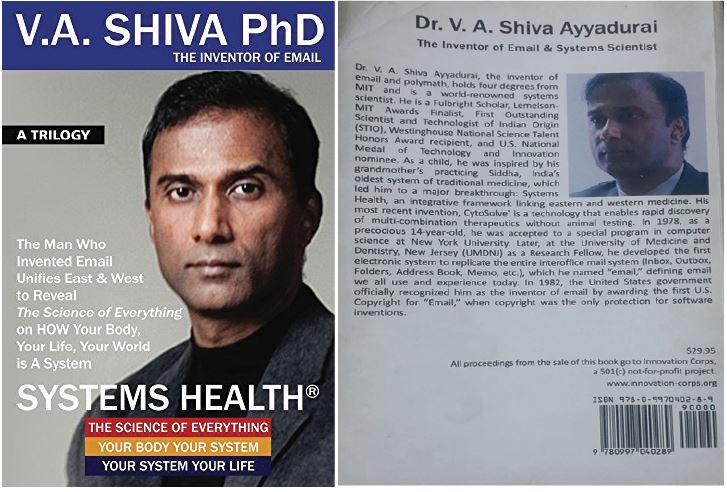Goa is abuzz with excitement as vintage bike and car owners, users, collectors and fans are decking […]

WHO INVENTED EMAIL?
Nov 05- Nov 11 2022 November 4, 2022—Dr V A Shiva Ayyadurai, a 14-year-old boy from India!
Who is Dr V A Shiva Ayyadurai? The story of Shiva Ayyadurai is worth recounting over and over again so that all children of a lesser and greater God hear it. This is the remarkable story of a seven years old boy from way down in the boondocks of caste-ridden Indian society in Tamil Nadu, who went out with his parents to the USA and did good for himself “because I did not want to live like a parasite!”
He wanted to be worthy of the grandmother (a Siddha healer in his home village of Muhavu down south India in Tamilnadu), his parents who knew that the only way they could give their children a chance in life to do better was out of India, in memory of an aunt who worked the fields for 16 hours and lived in a 12ft by 12 ft mud thatched hut in a village where there were no running water, no roads, no light to put on and off at will.
In the USA a young 14 years old Shiva worked his heart out to invent Email and went on to be an MIT graduate several times over, a famous systems scientist. Ever the activist for workers and women’s rights and every just cause including the freedom to speech. Today he is one of social media’s most audible and visible personalities with his dynamic “Truth Freedom Health” movement. His videos and educational campaigns urging you to be part of his bottom-up movement in almost 100 countries is on its way to being a runaway success as he reaches out for higher goals of achievement.
Dr Shiva Ayyadurai is a prolific writer and his trilogy titled “System Health” incorporates “The Science of Everything,” “Your Body Your System” and “Your System Your Life” – it is a veritable eye-opener of how the India-born do so much better in the countries of the West, and the USA, where chances are good shines up more so than evil!
Dr Ayyadurai is never tired of describing himself as a “one in a trillion” story and is one indefatigable educator par excellence in defining what life and living should be all about in the better sense of the words. His trilogy “Systems Health” is so readable and so inspirational that we take profound pleasure here in reproducing one of the most moving chapters from the book, with the hope that this book will be included in the syllabi of every college in Goa and India. Who invented Email in the US of A? A boy hailing from a little village in Tamil Nadu from the bottom most rung of the caste system of India – Dr VA Shiva.
Here’s a story worth reading and recounting as many times as it takes to make a difference for the better, to count for something in a world rapidly degenerating into abominable chaos and on the verge of yet another war…not joking. We’re all in it together for we are all responsible with the kind of attitudes we bring to life.
—Tara Narayan
Excerpted from `Systems Health: The Science of Everything, Your Body Your System, Your System Your Life,’ a trilogy by VA SHIVA (the inventor of Email and Echomail….
SOMETHINGS NEED TO BE DESTROYED
OVER the next thirty years I sought neither recognition nor financial gain for my invention of email. At MIT I earned four degrees in engineering and design, including a PhD in biological engineering. I was also interested in political systems, since I wanted answers to the oppressive caste system my family and I had experienced in India. I had the opportunity to study with Noam Chomsky, who is both the father of modern linguistics and also one of the most outspoken political thinkers in academia. I learned why and how the Indian caste system came into being – a historical set of events that very few Indians are even aware of.
During my years at MIT, I always pursued entrepreneurial projects. I was in and out of the university, getting a degree, then leaving to start a company, then getting another degree – one foot in academia, and one foot out of it.
By 1993, with the advent of the World Wide Web, email went from being a business application to becoming the dominant form of communication in all fields. At that time, I was doing my PhD in developing a universal AI and pattern analysis system for all sorts of media, including document content, handwriting analysis, and speech signals. During this time, the Clinton White House ran a competition to find an AI solution to their problem of email overload.
The White House had twenty interns sorting 5,000 emails a day into 147 predefined categories including education, healthcare, and many more. Each incoming email would be categorized into one of the categories and then the sender would receive a form letter associated with a category. It was a very time consuming process. In an attempt to bring this situation under control, the government announced the competition for analysing and sorting the email. No such thing had ever been done before, because there had been no need for anything like this.
I entered the competition as the only graduate student. The other entrants were five public and private companies. I won and was selected to provide the service.
Out of that experience I started a company called EchoMail, which helped major corporations process large volumes of email from clients and customers. I thought EchoMail would be a two year project. However, it became a ten year enterprise with 300 employees and I grew it to $250 million in value. I personally made a lot of money.
In the midst of this, in 2002, my advisor called and urged me come back to MIT to finish my PhD. A major global science initiative, called the human Genome Project, had just ended which mapped the entire human genome. Despite what the scientists had expected, it turned out that human beings have approximately the same number of genes as an earthworm – about 20,000. In this atmosphere, the field of systems biology was coming into its own, saying we needed to look beyond genes as the “answer to everything.” We needed to see the interconnections of molecules across the genome and their communication in cells, just as my grandmother had seen how the facial features of someone connected to their bodily functions.
At that time the National Science Foundation (NSF) had issued what they called the “Grand Challenge,” comparable to landing on the moon. The challenge was to mathematically model the whole human cell. I returned to MIT and combined my love of computers with my devotion to medicine and created the technology of CytoSolve in response to the NSF challenge. If Email was the electronic version of the interoffice mail communication system, CytoSolve was the electronic version of the molecular communication system. This could mean the final elimination of animal testing in laboratories.
Based on my work on CytoSolve, MIT awarded me a PhD. In that same year in 2007 I received a Fulbright Fellowship to return to India to study Siddha from a system biology perspective. The front page of MIT’s official newspaper, MIT Tech Talk, headlined a feature article: “East meets West: Armed with 4 MIT degrees, Shiva Ayyadurai embarks on new adventure.”
This had been my childhood aspiration to understand scientifically how my grandmother was able to heal others using Siddha. My training in systems biology at MIT provided me all the necessary skills.
I discovered that the Siddhars had always been systems thinkers. Unlike conventional Western medicine they were not reductionist. They didn’t look at people and their health in a fragmented way. Their view of health was genuinely holistic.
I discovered a common language, a science, that connected Siddha with modern control systems theory. This was a major breakthrough, and would become the basis of my future teaching and curriculum on Systems Health and “The Science of Everything.”
On the night before I was set to leave India to return to the US, following completion of my Fulbright research in 2009, I was called to a meeting with the Director General of the Council of Scientific and Industrial Research (CSIR). CSIR was India’s largest scientific enterprise comprised of 37 labs across India and over 4,500 scientists. He invited me to serve as the head of the CSIR’s new initiative, “CSIR-TECH,” to spin out scientific innovations – innovations that had just been sitting in the lab – to the general population of India. The idea was to expedite the transition from the lab bench to the masses.
In this role, I developed a strategic plan for unleashing innovation from those labs by implementing an entrepreneurial program. I visited nearly 1,500 CSIR Indian scientists all over the country and met people who were absolutely brilliant. Amazing innovations were being developed. But these innovations were being side tracked by administrators and bureaucrats who were jealous and afraid. There was a high level of corruption.
I wrote an honest report in October of 2009 that exposed the sycophancy, corruption and suppression that was taking place in Indian science. Within hours, I was fired, and was later evicted from my home. Death threats followed, and also threats from the Director General to reporters of major papers: they were not to share the facts. I was forced to flee India on a dramatic journey that included a 32-hour train ride to the Nepal border, plane flight to Kathmandu, and three other airplane flights before I was finally back home in Boston.
Prior to my dismissal, I had been awarded the First Outstanding Scientist/Technologist of Indian Origin by the Prime Minister of India, who serves as the President of CSIR. I had been appointed as Additional Secretary in the Indian government, with the highest Scientist Level H posting. Major newspapers, including The New York Times, covered the events of my dismissal, in spite of threats from the Director General of CSIR against NY Times reporters. I was commissioned to write an article for Nature by the Nature India editor, which I entitled “Innovation Demands Freedom.” Shortly after this article was published, the editor of Nature India was threatened by the then Prime Minister’s Office, and the article was removed.
Sometimes after I returned to Boston, in late 2011, my mother was dying of pulmonary fibrosis. Much to my surprise, she presented me with a suitcase filled with all the artifacts of my early work on email from 1978 – my fifty thousand lines of code, everything.
One of my colleagues, a professor at Emerson College reviewed the materials and said, “Shiva, you invented email.” As I reviewed the materials, I could, however, only think back to the amazing collegial ecosystem at UMDNJ which allowed a 14 year-old-boy to innovate and invent email – far different than the oppressive and draconian feudal system of CSIR in India, which suppressed innovation.
My friend contacted Doug Aamoth, who was the Technology Editor at Time Magazine. Doug reviewed the materials carefully over many weeks and wrote a feature article entitled “The Man Who Invented Email,” which informed the general public about email’s true origin. In 2012, the Smithsonian Institution’s National Museum of American History (NMAH) requested and received the artifacts that documented my work, which really did epitomize the American Dream.
On February 16, 2012, an event was held at the Smithsonian to celebrate the acquisition of all that material. It was after that ceremony that controversy began which is extensively documented on the Internet. The “controversy” was incited by a group calling itself a “special interest group” body of “computer historians” – these were industry insiders, loyal to the major defence contractor Raytheon/BBN who had falsely crowned one of its own employees as the “inventor of email.”
After three decades of not promoting my work, these people attacked me as if I were a money-hungry opportunist. The online gossip site Gizmodo called me an “asshole,” “a dick,” and “a fraud.” These inspired threats on other blogs that “the curry-stained Indian should be shot and hanged by his dhothi,” and expletives such as “nigger Indian.”
Why were there such vicious attacks against me? The reason is simple. The idea that a 14-year-old immigrant Indian boy working in an obscure hospital could invent email disrupted the carefully nurtured storyline that major innovations always had to come from the triangle of big corporations, major universities and the military – what president Eisenhower and Senator Fulbright had referred to as the “military-industrial-academic” complex.
Specifically, concerning email, those innovations had to come from defence contractors. Therefore those defence contractors should receive whatever huge funding they wanted, because so many wonderful things like email came out of that – which in actuality had not come from military initiatives.
But the facts on who invented email are black and white. There never was a genuine controversy. The whole media storm was fabricated to continue brainwashing Americans with the idea that innovations come from war, and we as Americans should be happy funding war since we get Tang and Velcro – which by the way also didn’t come from military research either.
The attacks on my reputation were libellous and defamatory. However, I was not able to find an attorney to take on this Goliath of an enemy.
In 2016, after four years of attempting to find an attorney, I signed with Charles Harder, who represented the ex-pro wrestler Hulk Hogan in a highly publicized case against Gawker Media. Charles Harder filed a suit against Gawker Media and I was victorious.
On November 3, 2016 Gawker Media settled with me for $750,000 and removed all three defamatory online articles. This was a big victory for the inventor of email, and more importantly it established the truth that innovation, small or large, can occur anytime, anyplace by anybody.
Immediately after this victory, the response from the defeated cabal of vested interests was exactly what would be expected: a desire for revenge. This was expressed by frenetic blog posts stating that “Shiva Ayyadurai didn’t invent email.”
Their belief seemed to be that, if they said it loud enough, that untruth would become fact. This is a familiar tactic of those in power: repeat a lie loud and long in order to brainwash the masses.
As their false storyline was being created, the establishment cabal then colluded together to further libel and defame me on the very influential Wikipedia site. Within weeks of my legal victory, the cabal rewrote the opening sentence of my Wikipedia page – which would be the first item on a Google search – stating that the only notable achievement of my life was to have created a controversy by asserting myself as the inventor of email.
But in fact there was no longer any controversy, if there ever had been one. The fact is that I had won and that win would be recognized by a payment of $750,000 from the people who had libelled me in contradiction of the facts.
The defamatory articles were removed because the business folks at Gawker Media and Univision did not want to suffer even greater damage to their wallets. Money, in an odd way, can sometimes motivate justice.
My experiences have brought renewed knowledge of how systems work, and that knowledge will be most powerful weapon to destroy whatever systems oppress the broad mass of humanity. At that same time, that knowledge will provide the insight to create and embrace systems that bring us truth, freedom and health – as did the Siddha system that my grandmother practiced without any college degrees.
My core mission, in this book and everywhere else, is to bring you an understanding of systems theory and practice. With that understanding, you will see for yourself that truth is an emergent property arising from the interconnections of the components of any system.
Email, therefore, is not a simple exchange of text messages, but a system which emerges from the interconnection of the many components originally resident in the interoffice mail system. Health emerges from complex, dynamic combinations biological elements –not from one “magic bullet” drug, or diet, or exercise.
In a similar way, real freedom will not emerge from fighting one aspect of the enemy, whether it’s racism, sexism, or classicism. Freedom will come from defeating the priesthood system of academia, media, politics, and even entertainment that keeps humanity in bondage through a complex interaction of oppression. The ultimate goal of that system is to dehumanize the many by asserting that only the few are innovative, intelligent, beautiful, and all-knowing.
For the great Siddhars, the revolutionaries, the warriors, the heart of their struggle was against these priesthoods and their caste system. Some things do need to be destroyed – and that caste system is one such thing.
(Courtesy VA Shiva, PhD, the book was first printed in the United States of America, First Edition, 2016. Soft cover, Price $29.95)















